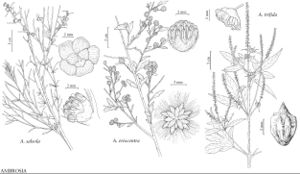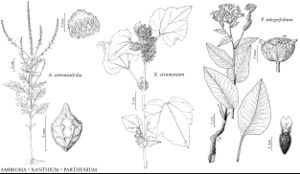Ambrosia
Sp. Pl. 2: 987. 1753.
Gen. Pl. ed. 5, 425. 1754.
Annuals, perennials, or shrubs, 10–400+ cm (usually rhizomatous). Stems erect, decumbent, or prostrate, branched. Leaves usually cauline; opposite ± throughout or opposite (proximal) and alternate or mostly alternate; sessile or petiolate; blades (or lobes) deltate, elliptic, filiform, lanceolate, linear, obovate, ovate, or rhombic (and most intermediate shapes), usually pinnately, sometimes palmately lobed, ultimate margins entire or toothed, faces hairy or glabrate, usually glanddotted or stipitate-glandular. Heads discoid (unisexual, pistillate proximal to or intermixed with staminates, staminates usually in racemiform to spiciform arrays; rarely, single plants all or mostly staminate or pistillate). Pistillate heads: phyllaries 12–30 (–80+) in 1–8+ series, outer (1–) 5–8 distinct or ± connate, herbaceous, the rest (sometimes interpreted as paleae) ± connate, usually with free tips forming tubercles, spines, or wings (the whole becoming a hard perigynium or “bur”); florets 1 (–5+), corollas 0. Staminate heads: involucres cupshaped to saucer-shaped, 1.5–6+ mm diam.; phyllaries 5–16+ in ± 1 series, ± connate; receptacles ± flat or convex; paleae spatulate to linear, membranous, sometimes villous, hirtellous, and/or glanddotted or stipitate-glandular, sometimes none; florets 5–60+; corollas whitish or purplish, ± funnelform, lobes 5, erect or incurved; staminal filaments connate, anthers distinct or weakly coherent. Cypselae (black) ± ovoid or fusiform, enclosed within globose to obovoid, pyramidal, pyriform, obconic, or fusiform, hard, smooth, tuberculate, spiny, or winged “burs”; pappi 0. x = 18.
Distribution
Tropical to subtropical and temperate New World, mostly North America, some established in Old World
Discussion
Species 40+ (22 in the flora).
Selected References
Lower Taxa
Key
| 1 | Shrubs | > 2 |
| 1 | Annuals, perennials, or subshrubs (usually rhizomatous) | > 10 |
| 2 | Leaf blades and/or lobes filiform (0.5–1.5 mm wide); burs winged, wings 5–20+, oblanceolate to cuneiform or flabellate to orbiculate | > 3 |
| 2 | Leaf blades and/or lobes mostly deltate, elliptic, lanceolate, ovate, rhombic, or triangular (broader than filiform); burs spiny, spines 8–30(–80+), ± lanceolate (sometimes navicular at bases) to subulate or acerose (tips sometimes uncinate) | > 4 |
| 3 | Wings on burs mostly around middles, 2–3 × 1–2 mm; flowering (May–)Aug–Nov | Ambrosia monogyra |
| 3 | Wings on burs ± scattered, 3–4(–6) × 2–4(–8) mm; flowering Mar–May(–Jun) | Ambrosia salsola |
| 4 | Leaf blades (green) hirsutulous to hirtellous abaxially | > 5 |
| 4 | Leaf blades (often gray, silvery, or white) ± densely pilosulous, puberulent, scabrellous, strigillose, or tomentulose abaxially | > 6 |
| 5 | Leaves: petioles 0–2 mm, blades elliptic to ovate, margins spiny-toothed | Ambrosia ilicifolia |
| 5 | Leaves: petioles 10–35 mm, blades lanceolate to narrowly triangular, margins coarsely toothed (not spiny) | Ambrosia ambrosioides |
| 6 | Leaf blades (1–)2–3-pinnately lobed; pistillate heads often intermixed with staminates | Ambrosia dumosa |
| 6 | Leaf blades not pinnately lobed (irregularly toothed to ± laciniate in A. eriocentra); pistillate heads proximal to staminates | > 7 |
| 7 | Leaf blades elliptic, lance-linear, or rhombic (margins irregularly toothed to ± laciniate); pistillate florets 1; burs densely villous and stipitate-glandular | Ambrosia eriocentra |
| 7 | Leaf blades deltate, lance-deltate, ovate, or rounded-deltate; pistillate florets (1–)2(–3); burs puberulent to tomentulose and/or ± stipitate-glandular | > 8 |
| 8 | Leaf blades: bases cordate to truncate, abaxial faces densely puberulent (including veins) | Ambrosia cordifolia |
| 8 | Leaf blades: bases cuneate to truncate, abaxial faces tomentulose (mostly between veins) | > 9 |
| 9 | Leaf blades ovate to rounded-deltate; burs usually tomentulose (little, if at all, stipitate-glandular) | Ambrosia chenopodiifolia |
| 9 | Leaf blades deltate to lance-deltate; burs usually stipitate-glandular (little, if at all, tomentulose) | Ambrosia deltoidea |
| 10 | Annuals | > 11 |
| 10 | Perennials or subshrubs | > 14 |
| 11 | Leaves mostly opposite (usually some blades palmately 3–5-lobed) | Ambrosia trifida |
| 11 | Leaves mostly opposite (in A. bidentata, opposite and alternate, or mostly alternate, usually some or all blades 1–2-pinnately lobed, except in A. bidentata with 0–4 basal lobes) | > 12 |
| 12 | Leaf blades with (1–)2(–4) basal lobes or not lobed; peduncles of staminate heads 0–0.5 mm; burs 5–8 mm | Ambrosia bidentata |
| 12 | Leaf blades mostly 1–2-pinnately lobed; peduncles of staminate heads 0.5–2 mm; burs 2–5 mm | > 13 |
| 13 | Involucres of staminate heads (2–)3–5(–7) mm diam. (usually each with 1–5+ black nerves); burs ± fusiform to obpyramidal, 3–5 mm, spines 8–18+, 2–4(–5) mm | Ambrosia acanthicarpa |
| 13 | Involucres of staminate heads 2–3+ mm diam. (usually without black nerves); burs ± globose to pyriform, 2–3 mm, spines or tubercles 3–5+, 0.1–0.5+ mm | Ambrosia artemisiifolia |
| 14 | Stems ± prostrate or decumbent (usually beaches or strand) | > 15 |
| 14 | Stems ± erect (rarely beaches or strand) | > 16 |
| 15 | Staminate involucres 2–3+ mm diam.; burs ± pyriform, 1–2 mm, spines or tubercles 0–5+, 0.1–0.5+ mm | Ambrosia hispida |
| 15 | Staminate involucres 4–6+ mm diam.; burs fusiform to ± pyriform, 4–7+ mm, spines 8–16+, 0.5–1.5+ mm | Ambrosia chamissonis |
| 16 | Leaf blades sometimes 1–2(–3)-pinnately lobed (if lobed, lobes mostly deltate to lanceolate); involucres of staminate heads usually ± saucer-shaped (cup-shaped in A. cheiranthifolia from s Texas) | > 17 |
| 16 | Leaf blades usually 1–4-pinnately lobed (lobes or non-lobed blades mostly lanceolate to linear); involucres of staminate heads cup-shaped | > 19 |
| 17 | Leaf blades elliptic to lance-elliptic, 50–80(–180) × 12–20(–50+) mm, 1–2(–3)-pinnately lobed (lobes ± deltate), abaxial faces densely finely scabrellous | Ambrosia tomentosa |
| 17 | Leaf blades elliptic, lanceolate, oblanceolate, oblong, or ovate, 20–60(–100+) × 8–45(–75+) mm, 1(–2)-pinnately lobed or not lobed, abaxial faces densely sericeous, strigillose, or strigose | > 18 |
| 18 | Leaves: petioles none, blades lanceolate or lance-elliptic to lance-oblong or oblanceolate, 20–50(–70+) mm, rarely ± pinnately lobed (lobes ± deltate) | Ambrosia cheiranthifolia |
| 18 | Leaves: petioles 10–45+ mm, blades elliptic to ovate, 45–60(–100+) mm, usually 1–2-pinnately lobed (lobes ± lanceolate) | Ambrosia grayi |
| 19 | Burs: spines (1–)8–13+, subulate, tips usually uncinate | > 20 |
| 19 | Burs: spines or tubercles 0 or 1–6, stoutly conic to ± acerose, tips straight | > 21 |
| 20 | Leaf blades mostly linear (some 1-pinnate, lobes linear); involucres of staminate heads 4–6+ mm diam | Ambrosia linearis |
| 20 | Leaf blades lanceolate to ovate, laciniately 2–4-pinnately lobed (lobes ± lanceolate); involucres of staminate heads 1.5–3+ mm diam | Ambrosia confertiflora |
| 21 | Leaf blades deltate to elliptic, 15–35(–75) × 12–25(–45) mm, laciniately (1–)2(–3)-pinnately lobed; burs ± fusiform, 2–2.5 mm, strigillose | Ambrosia pumila |
| 21 | Leaf blades deltate to lanceolate, 20–60(–140) × 8–35(–50+) mm, pinnately toothed or 1(–2)-pinnately lobed; burs ± obpyramidal to globose, 2–3 mm, hirsutulous | Ambrosia psilostachya |

